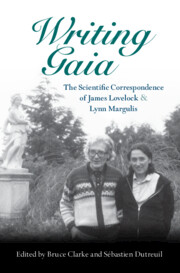Book contents
- Writing Gaia: The Scientific Correspondence of James Lovelock and Lynn Margulis
- Reviews
- Writing Gaia: The Scientific Correspondence of James Lovelock and Lynn Margulis
- Copyright page
- Epigraph
- Table of Contents
- Figures
- Contributors
- Foreword by James Lovelock
- Preface
- Acknowledgements
- Introduction
- Part I 1970–1972
- Part II 1973–1979
- 1973
- 1974
- 1975
- 1976
- 1977
- 1978
- 1979
- Part III 1980–1991
- Part IV 1992–2007
- Part V Commentaries on Lovelock and Margulis
- Glossary of Names
- Glossary of Terms
- Bibliography
- Index
1974
from Part II - 1973–1979
Published online by Cambridge University Press: 28 July 2022
- Writing Gaia: The Scientific Correspondence of James Lovelock and Lynn Margulis
- Reviews
- Writing Gaia: The Scientific Correspondence of James Lovelock and Lynn Margulis
- Copyright page
- Epigraph
- Table of Contents
- Figures
- Contributors
- Foreword by James Lovelock
- Preface
- Acknowledgements
- Introduction
- Part I 1970–1972
- Part II 1973–1979
- 1973
- 1974
- 1975
- 1976
- 1977
- 1978
- 1979
- Part III 1980–1991
- Part IV 1992–2007
- Part V Commentaries on Lovelock and Margulis
- Glossary of Names
- Glossary of Terms
- Bibliography
- Index
Summary
I hope your silence means you are too busy to write. Selenium, it seems to me, will be a winner. See enclosed. The enzyme is required for glycine reduction to NH4 and the organisms he has listed here are extremely primitive on other grounds. I will monitor the selenium biochemistry paper when it comes out and keep you posted. What actually have been your ecological observations re dimethyl selenide?
- Type
- Chapter
- Information
- Publisher: Cambridge University PressPrint publication year: 2022

